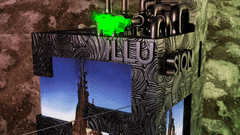

Real-time showreel 2023
My real-time showreel, created by Limbicnation, is a captivating display of interactive and immersive content rendered in Unreal Engine. This showcase highlights my best work utilizing Unreal Engine technology. · A Real-Time Showreel 2023 „Real-Time Showreel 2023“ von Gero Doll ...
0

Quantum Passage
· Neon_Night_Sprint Step into the future with "Quantum Passage", a sci-fi animated short that brings to life a world of adventure and possibility. Utilizing the latest technology from Unreal Engine 5, "Quantum Passage" offers a visual feast for sci-fi fans, set against a backdrop of stunning graphics and captivating storytelling. Get ready to explore the frontiers of imagination and join me on this intergalactic journey.
0

NFT Cryptoart
Get this gem 💎 "Polygon-geometries" collectible! https://t.co/Q0sTZO8irj #rarible #ethereum #nonfungible #digitalasset #nft #aiart #limbicnation via @rarible pic.twitter.com/JmW4XtoYvw — Gero Doll (@Limbicnation) September 30, 2022 https://artstn.co/pp/ap/JmQ2q Slime Face by limbicnation3d on Sketchfab LINK to NFT ...
0

Beyond Heaven and Hell
This is a short video that shows how to create videos with generative AI models in a relatively short time. It's about heaven and hell. Demonic energies appear to be emanating from where they reside from within the earth. Evil shall be vanquished for eternity! Thanks to jpsaiart for providing information to the prompts! I have slightly modified them. I have tried to clone my voice to add the speech to the video, however it still does sound a robotic. :) I am running Disco Diffusion Model locally, with an Nvidia RTX 3090Ti Graphics card. For those how are interested I might try to do a tutorial on that. The Artwork is by Gero Doll | Limbicnation Music Track: Heaven and Hell (Part 2) Artist: Jeremy Blake YouTube Audio Library licence...
0

🐝 The_Sunflowers_and_the_Bees 🐝🍯
🐝🍯 I like sunflowers, and I like to watch bees. There is something very special about sunflowers and bees, and I like to see them. I like to think that if we had the technology and tools to observe them, we would be amazed at the dance of these tiny animals. 🐝 Visuals: Limbicnation Music: Metamorphosis Artist:Quincas Moreira...
0

The Flow of (AI) 🤖💻
The Flow of (AI) 🤖💻 AI-assisted law firms will soon be ubiquitous. Visual: Limbicnation Music: Info: The Tower of Light - Beginnings (Intro) (no copyright music) Genre: Cinematic Mood: Dramatic...
0

NFT: CheckMateEGO
Rarible! NEW NFT | COLLECTIBLE | CHeckMateEgo | MINTED on February 13th 2021! Get it while it's HOT 🔥🔥🔥https://t.co/YwjRD86kxr #rarible #ethereum #nonfungible #cryptoart #digitalasset #nft via @rariblecom pic.twitter.com/0bNqgnqm6P — LIMBICNATION ART (@Limbicnation) February 13, 2021 ...
1

ILLUSION
It is early days, but could these new digital assets be a subject of a brighter future? The question is, what value do these digital assets hold? I might argue that it is the imminent signature and transaction linked into one gigantic network that evaluates and stores data of the specific value at the given time.. Link to cryptoart “Illusion”, was an experimentation and metaphor to depict digital currencies like Bitcoin (BTC) And Ethereum (ETH) linked with machine learning. In this surreal film, I would like to show the potential of digital assets and machine learning algorithms to generate unique digital items (NFT) NFT’s might change the digital art market and are already doing so, by kickstarting it into wider range of acceptance as a true artform. As we know, the machine needs...
0

COVIDNINETEEN
“The Altering of Reality” and CovidMasks Masks and machines are older than we think. There is a specific obscurity about them. Mythologically the fascination of a mask has accompanied humanity since the dawn of Time. Neolithic stone age masks date back to 9000 years! The film CovidMasks depicts a psychotic state of a perception through an unaffected being. The point of view determines the absurdity of a deprecated perception as a collective whole. “The collective” whole’s delusion of reality would define this specific state of perception more precisely. Something as powerful as a mask and a machine combined however, could trigger an even more futuristic concept of the fusion of man and machine. This video clearly depicts a dystopian outcome of a “cyborg human” fully dominated by the machine entity. The AI Fusion - Quantum – Computer!
0
